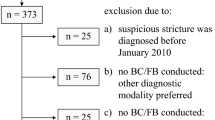Abstract
Background and Aim
Diagnosis of the bile duct cancer still needs more accuracy. Studies on endoscopic retrograde cholangiopancreatography (ERCP)-guided brushing cytology were carried to evaluate the role of the endoscopic transpapillary brushing cytology for the diagnosis of bile duct cancer.
Patients and Method
The study involved 76 consecutive patients who underwent ERCP-guided bile duct cytology for the diagnosis of bile duct cancer from 2008 to August 2012. Three types of cytological specimens were obtained using different sampling methods, i.e., bile aspiration cytology (BAC), brush tip cytology (BTC), and post brushing bile cytology (PBC), to investigate their diagnostic abilities, and comparatively studied with each macroscopic type of the surgically resected specimens.
Results
The cancer-positive rate was 67.1 % (BAC alone: 41.9 %), and the use of BTC and PBC in addition to BAC yielded a statistically significant increase of the cancer-positive rate (p = 0.0031). In 34 resected cases, the cancer-positive rate in relation to the macroscopic type was improved by the addition of BTC and PBC to BAC alone for the papillary (87.5 vs. 40.0 %, p = 0.071) and nodular (100 vs. 70.0 %, p = 0.0603) types, but not for the flat type (62.5 vs. 57.1 %; p = 0.7651).
Conclusion
The diagnostic ability of ERCP-guided brushing cytology could be improved by the addition of PBC. However, the cancer-positive rate was the lowest for the flat type of bile duct cancer.


Similar content being viewed by others
References
Kurzawinski T, Deery A, Dooley J, Dick R, Hobbs K, Davidson B. A prospective controlled study comparing brush and bile exfoliative cytology for diagnosing bile duct strictures. Gut. 1992;33:1675–1677.
Foutch PG, Kerr DM, Harlan JR, Kummet TD. A prospective, controlled analysis of endoscopic cytotechniques for diagnosis of malignant biliary strictures. Am J Gastroenterol. 1991;86:577–580.
Bardales RH, Stanley MW, Simpson DD, et al. Diagnostic value of brush cytology in the diagnosis of duodenal, biliary, and ampullary neoplasms. Am J Clin Pathol. 1998;109:540–548.
Mansfield JC, Griffin SM, Wadehra V, Matthewson K. A prospective evaluation of cytology from biliary strictures. Gut. 1997;40:671–677.
Schoefl R, Haefner M, Wrba F, et al. Forceps biopsy and brush cytology during endoscopic retrograde cholangiopancreatography for the diagnosis of biliary stenoses. Scand J Gastroenterol. 1997;32:363–368.
Ponchon T, Gagnon P, Berger F, et al. Value of endobiliary brush cytology and biopsies for the diagnosis of malignant bile duct stenosis: results of a prospective study. Gastrointest Endosc. 1995;42:565–572.
Sakata J, Shirai Y, Wakai T, Nomura T, Sakata E, Hatakeyama K. Catheter tract implantation metastases associated with percutaneous biliary drainage for extrahepatic cholangiocarcinoma. World J Gastroenterol. 2005;11:7024–7027.
Japanese Society of Biliary Surgery. General Rule for Surgical and Pathological Studies on Cancer of the Biliary Tract. 5th ed. Tokyo: Kanehara & Co., Ltd; 2003.
De Bellis M, Sherman S, Fogel EL, et al. Tissue sampling at ERCP in suspected malignant biliary strictures (part 1). Gastrointest Endosc. 2002;56:552–561.
De Bellis M, Sherman S, Fogel EL, et al. Tissue sampling at ERCP in suspected malignant biliary strictures (part 2). Gastrointest Endosc. 2002;56:720–730.
dePeralta-Venturina MN, Wong DK, Purslow MJ, Kini SR. Biliary tract cytology in specimens obtained by direct cholangiographic procedures: a study of 74 cases. Diagn Cytopathol. 1996;14:334–348.
Kocjan G, Smith AN. Bile duct brushing cytology: potential pitfalls in diagnosis. Diagn Cytopathol. 1997;16:358–363.
Logrono R, Kurtycz DF, Molina CP, Trivedi VA, Wong JY, Block KP. Analysis of false-negative diagnoses on endoscopic brush cytology of biliary and pancreatic duct strictures: the experience at 2 university hospitals. Arch Pathol Lab Med. 2000;124:387–392.
Osnes M, Serck-Hanssen A, Myren J. Endoscopic retrograde brush cytology (ERBC) of the biliary and pancreatic ducts. Scand J Gastroenterol. 1975;10:829–831.
Kitajima Y, Ohara H, Nakazawa T, et al. Usefulness of transpapillary bile duct brushing cytology and forceps biopsy for improved diagnosis in patients with biliary strictures. J Gastroenterol Hepatol. 2007;22:1615–1620.
Pugliese V, Conio M, Nicolò G, Saccomanno S, Gatteschi B. Endoscopic retrograde forceps biopsy and brush cytology of biliary strictures: a prospective study. Gastrointest Endosc. 1995;42:520–526.
Sugiyama M, Atomi Y, Wada N, Kuroda A, Muto T. Endoscopic transpapillary bile duct biopsy without sphincterotomy for diagnosing biliary strictures: a prospective comparative study with bile and brush cytology. Am J Gastroenterol. 1996;91:465–467.
Farrell RJ, Jain AK, Brandwein SL, Wang H, Chuttani R, Pleskow DK. The combination of stricture dilation, endoscopic needle aspiration, and biliary brushings significantly improves diagnostic yield from malignant bile duct strictures. Gastrointest Endosc. 2001;54:587–594.
Uchida N, Kamada H, Ono M, et al. How many cytological examinations should be performed for the diagnosis of malignant biliary stricture via an endoscopic nasobiliary drainage tube? J Gastroenterol Hepatol. 2008;23:1501–1504.
Yagioka H, Hirano K, Isayama H, et al. Clinical significance of bile cytology via an endoscopic nasobiliary drainage tube for pathological diagnosis of malignant biliary strictures. J Hepatobiliary Pancreat Sci. 2011;18:211–215.
Ohshima Y, Yasuda I, Kawakami H, et al. EUS-FNA for suspected malignant biliary strictures after negative endoscopic transpapillary brush cytology and forceps biopsy. J Gastroenterol. 2011;46:921–928.
Naito Y, Okabe Y, Kawahara A, Taira T, Kusano H, Kage M. Study on the cytology of the pancreatic duct by different sampling. J Jpn Soc Clin Cytol. 2007;46:7–11. (in Japanese with English abstract).
Taira T, Kawahara A, Yamaguchi T, et al. Morphometric image analysis of pancreatic disease by ThinPrep liquid-based cytology. Diagn Cytopathol. 2012;40:970–975.
Volmar KE, Vollmer RT, Routbort MJ, et al. Pancreatic and bile duct brushing cytology in 1000 cases: review of findings and comparison of preparation methods. Cancer. 2006;108:231–238.
Nishikawa T, Tsuyuguchi T, Sakai Y, Sugiyama H, Tawada K, Mikata R, et al. Factors affecting the accuracy of endoscopic transpapillary sampling methods for bile duct cancer. Dig Endosc. 2014;26:276–281.
Conflict of interest
None.
Author information
Authors and Affiliations
Corresponding author
Rights and permissions
About this article
Cite this article
Sasaki, Y., Okabe, Y., Ishida, Y. et al. Evaluation of Endoscopic Transpapillary Brushing Cytology for the Diagnosis of Bile Duct Cancer Based on the Histopathologic Findings. Dig Dis Sci 59, 2314–2319 (2014). https://doi.org/10.1007/s10620-014-3124-4
Received:
Accepted:
Published:
Issue Date:
DOI: https://doi.org/10.1007/s10620-014-3124-4




